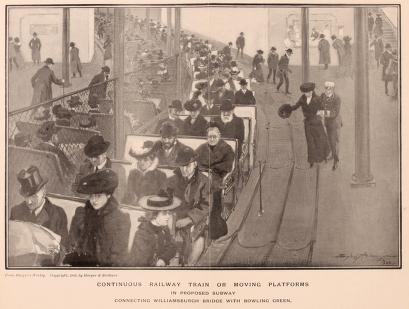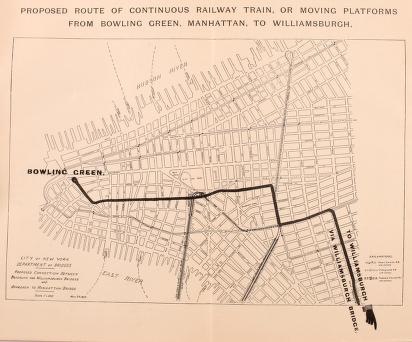JF Ptak Science Books Post 2188
I was looking through a batch of unusual history of technology material when I came upon an interesting idea in city planning by the Schmidt & Gallatin firm. The long title (Tranportation of Passengers in Greater New York by Continuous Railway Train, or Moving Platforms. Argument in favor of equipping the East River Bridges, and connecting subway to Bowling Green, Manhattan, with a continuous railway train or Moving Platforms) pretty much tells the story. This interesting and perhaps 1903-useful idea featured a system of moving sidewalks that allowed for sitting (for longer rides) and standing (for just a quick hop). The "platform" would move slowly enough to allow it to run continuously and fast enough to make it useful in geting people to their destinations a little faster, or at least get there without working up an Edwardian sweat. And it was being designed to get folks from Bowling Green at nearly the tip of Manhattan across the river and into Williamsburg in Brooklyn. [This pamphlet is available for actual purchase via our blog bookstore, here, under "city planning".]
That is a lot of continuously-moving surface area: a napkin estimate may be something like 25 acres of sidewalk/salon on-the-go. Unforntuantely the pamphlet doesn't have too much to say about powering this beast.
This is one version of the moving platform, which didn't leave much room for standing:
From the pamphlet:
"Moving Platforms for the conveyance of passengers were recommended by Mr. Horace Greeley thirty years ago. They were successfully operated, first, at the World's Columbian Exposition of 1893, where 2,700,000 people were transported. In 1896 they were installed at the Berlin Exposition, and again at the Paris Exposition of 1900, where they carried over eight million passengers. Few persons know what Moving Platforms are. From the face that sometimes they are called " Moving Side- walks," it is believed that they must be some sort of a pavement on rollers, on which it is difficult to step with safety and maintain equilibrium. The Moving Platforms are to all intents a railway, operated like other railways, propelled by electricity, with cars, seats, motors, passenger stations, ticket booths, guards, electric lights — in fact, everything belonging to a first-class railway."
"Where it differs from the ordinary railway is that the cars, or trains, are not running at intervals, but are coupled up continuously, so that there is no interruption of traffic at any time, but a large seating capacity at all times. It differs also in the construction of the cars, which are mere flat cars, provided with seats placed crosswise, and so ar- ranged that all rmssengers face in the direction of motion. Each of these seats may be made wide enough to accommodate one, two or more persons. The most approved plan is to provide seats on one side of the cars only and leave the other for passengers to walk, thus giving them an opportunity to further accelerate their speed if they so desire..."
It is an interesting idea for the time, but has its own share of problems. In some ways it was basically a slow elevated trains using just the car beds: a slower, cheaper, untunneled subway.





Comments